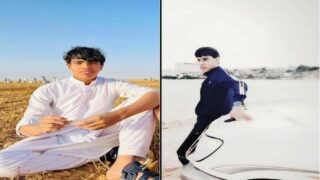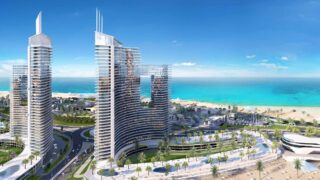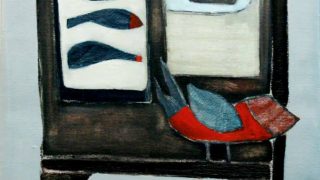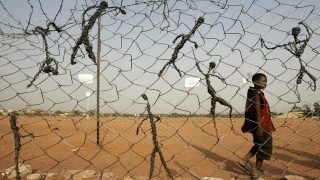
This publication has benefited from the support of the Rosa Luxemburg Foundation. This text may be reproduced in part or in full, provided the source is acknowledged.
The signing of the Camp David Agreement in the late seventies coincided in Egypt with the adoption of a free market policy. At the same time, the government withdrew from major projects and abandoned the social safety nets it used to provide to the citizens, while raising the slogan “Egypt First”. As a result, the grip on border security was loosened and the government’s control over economic activities decreased. The policy that the government implemented was described by one of the Egyptian newspapers as “all is allowed and anything goes”. A new sociopolitical reality was established on the borders of Egypt with the occupied Palestinian territories in the east, with Libya in the west and with Sudan in the south. This reality was not only different than the reality in the Delta, but also sometimes defiant to the hegemony of the state.
Sinai: “A Drug Haven”
Historically, the activity of smuggling in Sinai is linked to the resistance against the Israeli occupation. Between 1968 and 1970, the Bedouins used camels to smuggle arms to the Palestinian resistance in Jordan through Sinai and the Naqab desert. After the withdrawal of Palestinian organizations from Jordan, the smuggling routes were redirected towards Gaza and the West Bank.
After Israel’s retreat, Sinai was transformed into a “drug haven”. The Israeli newspaper “Haaretz” published a report on the 26th of November 2015, mentioning that out of five gangs dealing in drug trafficking in Egypt, Saudi Arabia and Jordan, three were run by Israeli intelligence and two by Egyptian intelligence as both agencies were interested in extracting information from the smugglers.
The Bedouins of Sinai found themselves marginalized after the boom in tourism investments in the south. They felt that the central government saw their land as ‘a chicken that laid golden eggs’, where privileged businessmen close to the government enjoyed the biggest shares of the tourism revenue. Hence, during the nineties and the beginnings of the millennium, the Bedouins turned the midland heights of Sinai into opium (Kheshkhash) fields. They became wealthy farmers and smuggled drugs. According to estimations done at that time, every acre of planted land produced 5 Kilograms of opium, worth 40 thousand dollars. The opium, transported to Cairo, was then refined and transformed into heroin, before being smuggled to Europe.
The Bedouins made hundreds of millions from this business and imported alcohol and electronic devices. The corruption of a few wealthy young men tore down some of the tribal clans. In addition, the Egyptian government was not keen to build special relationships with “elite” members of the tribes who were credible in their local communities and usually cooperative or easy to control. Instead, it chose to deal with certain individuals who were given privileges that allowed them to facilitate specific services to citizens. Consequently, in some tribes, such as the Sawarkeh and the Tarabine, some members would pledge allegiance to ISIS, while others would offer their loyalty to the Egyptian army and intelligence.
After the revolution of January 2011, Sinai was torn among its 26 tribes, 13 of whom lived in the south and 13 in the north, at the border with the Palestinian occupied lands (such as the Tarabine, Sawarkeh, and Hewat). Those in the north are the main smugglers of arms, drugs, tobacco, construction material, and, finally, humans, to Israel; and the most prominent among them are the Sawarkeh.
Mapping Smuggling
The road of smuggling was modified in the aftermath of the Israeli withdrawal from Sinai in 1982, as operations were done by sea or through underground tunnels. After Israel tightened its siege on Gaza, the prices of arms soared in comparison to gold and drugs. The Egyptian authorities turned a blind eye to the smuggling towards Gaza and the price of the Kalashnikov reached 15 thousand dollars. The weapons came from the Egyptian black market and were initially routed from Upper Egypt (Al-Sa’eed), or the Libyan border, or were even looted from the Egyptian army’s storage warehouses.
With the new millennium, and upon Israel’s retreat from the Gaza strip, thousands of underground tunnels were dug between Sinai and Gaza. During that phase, heavy weaponry was smuggled, such as Mortar missiles, RPG rockets, rocket launchers, and explosives. The smuggling chart underwent further changes with the presidency of Mohammad Morsi, who was affiliated with the Muslim Brotherhood.
Two main routes were then taken. The first was from east Sudan, Port Sudan in particular, where weapons came from either Somalia, Eritrea, or through Iranian ships that unloaded their cargo on the shores of the Red Sea. The Rashaida tribe, of Arabian Najd, lived in east Sudan and was the most active on this route. They used SUV cars to transport weapons to the tribes of the Red Sea coast, the Basharine and the Ababdeh, near the Egyptian-Sudanese border. Then they continued to the Suez Canal, where they loaded arms into small boats which went on to Sinai, and finally reached Gaza through tunnels.
Human Trafficking
Human trafficking among the northern tribes of Sinai intensified when Sudanese and Eritrean asylum seekers started to pass through Sinai on their way to Israel. The desert was uncontrolled, and the Israeli authorities claimed that the Egyptian authorities have ignored the easily penetrable Israeli border, allowing the Bedouins to create smuggling networks for asylum seekers. The largest Bedouin tribe in the north, the Sawarkeh, controls this trafficking.
The fees of human trafficking rose from 3 to 40 thousand dollars per person. Women were raped and some people were killed for the purpose of selling their organs. Many asylum seekers were tortured in underground rooms and enslaved to build villas for their captors and rapists. They plead with their relatives in Israel, Eritrea and Sudan to pay their ransoms in exchange for their release.
The New York Times estimates that seven thousand refugees were abused in four years (between 2009 and 2012), 4 thousand of whom died. The local inhabitants often found dead bodies of African refugees thrown into the desert. Sometimes their limbs were planted in the sand. "We keep them there until money is paid by their families", a smuggler told Deutsche Welle in March 2013. He said that they had been keeping the hostages in a low-rise building with no electricity, between the cities of El-Arish and Rafah, since the year 2009.
The newspaper said that members of the Rashaida tribe sometimes kidnapped refugees from their camps in Sudan and handed them over to the tribes in Sinai. Once they are done with one refugee, they abduct another. They leave them in a desolate desert area on the Israeli border, where they are exposed to the grave dangers of either being shot or imprisoned by the Israeli army if they cross the fence or being detained in miserable conditions in Egyptian prisons if they get caught.
A Human Rights Watch report said that since mid-2010’s, hundreds of thousands of asylum seekers, mostly Eritreans, have been abducted from eastern Sudan and sold to human traffickers in Sinai. The kidnappers collected thousands of dollars from them. Between 2000 and 2012, ransoms were raised from 3 thousand dollars to more than 40 thousand. Since June 2012, the trafficking route in Sinai discontinued, but the kidnappings kept on happening.
This system of kidnappings and torture was undisturbed and established without any resistance. It led to growing communication between the Bedouins of Sinai and the Rashaida tribe on the Egyptian-Sudanese border. The tribe kidnapped asylum seekers who fled to Egypt and did not intend to continue their journey to Israel. They were taken to camps in the Nile Delta before being deported to Sinai. Smuggler tribes and networks of trafficking, kidnapping, and blackmail earned astronomical sums of money in 2010, reaching hundreds of millions of dollars. That was until the beginning of the "Arab Spring".
After the Egyptian authority became unstable and gas pipelines were blown up, Israel erected a fence on the border to deter asylum seekers. However, Israel only began to regard Sinai as a real threat after an armed cell infiltrated the Israeli border in the summer of 2011, attacking an Israeli bus near Eilat. Normally, Israel viewed Sinai as a region divided into two parts: the north, land of terrorism, kidnapping and rape, and the south, land of beaches, tourism, palm trees and coral reefs.
The "Ansar Al-Maqdis" organization was founded in 2012. Some of its members were from the Sawarkeh tribe, others were foreigners. In November 2014, they declared their allegiance to ISIS. Human trafficking fell back in 2013, after Israel completed its fence to stop the flux of asylum seekers. However, the Sawarkeh did not stop the trafficking, and redirected to Libya. According to observers, human trafficking camps continued to operate in the Delta and the sums of money collected were used to fund extremist groups and their terrorist operations in Sinai.
Due to the Sawarkeh’s control over the coast of North Sinai and their proximity to Rafah and the Gaza Strip, they continued to be the most prominent smugglers of weapons and ammunition to Hamas, and developed a profitable tunnel trade. Disguising financial motives in the robes of religious jihad was a sufficient excuse for the perpetrators of crimes like arms and drugs smuggling, human trafficking, rape and looting.
A worrisome question remained: was it possible for the northern tribes to meddle in the south and ignite terrorist attacks to sabotage tourism and shake the government’s control, represented by the army and the police? The army is unable to monitor the desert roads or the long coasts. The southern tribes fear that the Tarabine would join the Sawarkeh in these activities (or that any other two tribes would collaborate). They worry that the tribes of the south and the center would not be able to rely on the army for protection anymore.
The Egyptian Government’s Role in Preventing Human Trafficking
A report published on the U.S. State Department’s official website in 2017 evaluated Egyptian efforts for combatting human trafficking through Sinai. The report asserted that even though the Egyptian government had made endeavors in this regard, it failed to meet the basic standards in its efforts to eradicate human trafficking.
The government had established three specialized courts to prosecute human traffickers, and it sued a government official for complicity in these crimes. It undertook a new national strategy and implemented several awareness campaigns and training programs addressing various forms of human trafficking. But despite all this, it could not meet the minimum required standards for combatting the main aspects of human trafficking, according to the American report. The Egyptian government did not announce any particular service it could provide to the victims. It did not offer them shelter, and on top of this, it prosecuted victims themselves for illegal acts, such as the violation of immigration laws. The Government continued to implement the Anti-Trafficking Act, which banned all forms of human trafficking in 2010. The Egyptian law provides for penalties ranging from 3 to 15 years in prison and fines.
It wasn’t until 2014 that the Egyptian government took a firm stand against smuggling through tunnels, demolishing over 3 thousand houses on both sides of the border between Gaza and Sinai, and creating a buffer zone that prohibited access to tunnels. This resulted in a humanitarian disaster.
In 2015, The New York Times reported that traffickers feared that Egypt had endorsed a strategy of “drowning the tunnels” in water so they would collapse, which threatened to end terrorist activities. Egypt had submerged part of the 9-mile border tunnels twice, causing serious damage to over 10 tunnels. Only 20 of the 250 tunnels are still in use, according to the New York Times, and some smugglers believed that this was the end for them. Abu Jazzar (nickname), a 42-year-old smuggler, told the newspaper that even airstrikes would have been easier to handle, since the tunnels could have been rebuilt afterwards.
Tunnels have been a central component in the economy of the Gaza Strip, which has a population of more than two million. Many goods, including cars, household appliances and construction materials enter the strip through tunnels which provide 260 thousand gallons of diesel per day and thousands of tons of cargo to the Gazan population. The Egyptian president Sissi has been intent on closing the Rafah border crossing, and the few tunnels that remain viable are only capable of transporting small-sized goods, such as cell phones and cigarettes.
The smugglers in Sinai found themselves cornered by both the Egyptian army which established buffer zones on the border with Gaza and flooded the tunnels, and ISIS, which took a stand against the smuggling of specific goods, such as cigarettes. This prompted some tribes to partake in the war against ISIS. In October 2017, the Tarabine tribe declared war against the "The Islamic State of Sinai". The Israeli ‘Channel Ten’ interpreted this event as a consequence of ISIS’ prohibition of smuggling operations. As a result, the Egyptian authorities and the army became more lenient regarding smuggling activities, especially since the projects planned for Sinai, in the south in particular, were unlikely to enable the wealthy Bedouins, who profited from the smuggling trade, to make legal investments.
Drug Trafficking
Egyptian traffickers, mostly Bedouins, come to the 200-mile border fence with Israel and throw bags of smuggled material at their Bedouin counterparts in the occupied territories. These, in turn, collect goods in SUV vehicles and trucks, to later redistribute them. The Israeli media says that these smugglers are not affiliated with ISIS and the terrorists, but that they are armed and open fire indiscriminately if faced by Israeli forces. The Israeli army's "Karakal" force is responsible for blocking their attempts.
Until 2013, Israel considered Sinai an alien wild region, a vast area for smuggling drugs, arms, cigarettes and trafficking sex workers. Israel completed its five-meter-high wall on the border with Sinai in January 2013. The wall led to an increase in the price of hash in Israel, and almost completely halted the flow of African migrants. However, the Sinai Bedouins are still able to smuggle other materials, such as heroin, to Israel.
Even though the Israeli soldiers block smuggling attempts it is not their main concern as the war against drugs is the responsibility of the Israeli police. Several Israeli army officials have stated that they were not in favor of sacrificing the lives of their soldiers in order to fend off drugs. However, they deal with smuggling as a security issue, fearing the infiltration of bags of explosives.
Libya: Smuggling as an Economy and Culture
The areas of western Egypt and eastern Libya have witnessed significant activities of arms’ smuggling to Upper Egypt (Al Sa’eed) through the oasis areas in the Egyptian western desert. Members of the “Awlad Ali” tribe were the most notorious smugglers of that region. Some of them reside in the city of ‘Marsa Matruh’, between Alexandria and the Libyan border, and another part lives inside Libya. These tribes turned to arms trafficking after the fall of Gaddafi.
Smuggling, especially for the Bedouins of “Awlad Ali”, is considered to be a coherent economic practice reflected in extensive social, political and cultural interactions that go beyond the borders of the country and its sovereignty, even when it threatens the integrity of a country’s territories. Smuggling is an activity that has historical roots beyond the "postcolonial states", according to a study on North Africa, published in 2017 by professor Thomas Huskin of the British Chatham House Institute.
The Awlad Ali tribe is found all along the coasts of the Egyptian Mediterranean Sea (500 Kilometers between Al Hamam and Al Salloum), and until the “Siwa” Oasis. 80 percent of the population of the city of Marsa Matruh are Bedouins (150 thousand people), and the Awlad Ali represent 85 percent of the population of the province.
When Marsa Matruh became a fixture in the touristic scene, the economic landscape in the western region changed, sparking sharp conflicts on land, between investors and the Bedouins, and among the Bedouins themselves. Between 2005 and 2011, new job opportunities in hotels and restaurants started to appear, slowly yet steadily, for young urban dwellers. Egyptian tourists, in particular, became primary customers of smuggled goods in the so-called ‘Libyan Market’ of Marsa Matruh.
The city of Al Salloum, on the border with Libya, is home for the Awlad Ali. From the city, they cross the border into Libya, and reach the central market in the Libyan city of Tobruk, located to the east of Berqa with a population of 100 thousand people. About 15 thousand of the Awlad Ali tribe live in Libya. This reaffirms the importance of tribal ties in the formation of smuggling networks, their success and expansion, and their ability to secure social protection.
On the Egyptian-Libyan border, the activities of the Bedouins differ from those practiced in Sinai, despite the Awlad Ali tribe’s persistent criticism of the Egyptian government’s ill-treatment. They believe that they are being economically and culturally marginalized and subjected to conditions similar to those of the colonial times. Investment projects in their land are not theirs, and when it comes to state services, they remain neglected. However, the Awlad Ali tribe does not consider itself to be a disadvantaged minority. Its members never partook in conflicts or wars, unlike the Bedouins of Sinai, who fought against colonialism and supported the Palestinian resistance to whom it smuggled arms ever since the inception of the occupying state of Israel. The Awlad Ali tribe was not a target for harsh military action and no security measures were taken against it in the "war on terror", even though some of the tribe’s members were involved in human trafficking or arms and drugs smuggling. The tribe benefited from the developmental initiatives that happened in the era of Jamal Abdel Nasser. In October 1959, a convoy was sent to work on reconstruction and land restoration. Schools, health centers and road networks were built but major ambitious projects did not get carried out because of the 1967 defeat. Some of the major pressing objections the Awlad Ali tribe raised in the face of the government were the lack of its official political representation and the government's failure to implement holistic economic policies in the tribe’s areas.
Gaddafi had financially supported some of the Awlad Ali families in order to gain influence on their relatives from the Egyptian side of the border. Some of the most important economic stimulants for smuggling across the Egyptian-Libyan border are the free trade ports across Libya. The price gaps are huge among tax-free or low-tax products, from gasoline to products coming from Morocco and Tunisia, such as perfumes, medicinal herbs, handicrafts, leather goods, clothing, electrical appliances, cosmetics and Chinese computers, as Egypt imposes high taxes on imports.
Kinship ties between Awlad Ali families enabled them to profit from the Libyan oil, as many of the Egyptian Awlad Ali members were seeking jobs related to the oil industry. The tribes of the province of Eastern Barqa in Libya are also well-connected to others in the western desert in Egypt. This provided them with the possibility of providing refuge to a family member in another country in the event of problems in the original country, and gave them the opportunity to engage in trans-national social and cultural life; an advantage that is unavailable to the Sinai Bedouins, for example, since they are trapped between Egypt and Israel.
The Egyptian-Libyan borders are the main gateways of arms and "jihadists”. Weapons and people are smuggled into Sinai, and from there to Gaza. The weapons travel from the suburbs of Benghazi to the port of Marsa Matrouh and then to Sinai.
Some reports uncover five main routes for arms trafficking: two through Marsa Matrouh, two from the Siwa Oasis and another one via fishing boats from Marsa Matruh to northern Sinai. The city of Salloum is a central point for arms control, which is specifically active in the north and south of the city and on the road connecting Marsa Matrouh to Salloum.
The Egyptian army sets up ambush posts to prevent smuggling. The most well-known of those is the Farafra Oasis ambush in the New Valley Governorate. In 2018, Egyptian security reported that it prevented 70 percent of smuggling operations, in comparison to 25 percent in the year 2017. Cooperation on the borders is practically null between the Libyan and Egyptian governments, as the implementation of the security agreements was hampered by the lack of political trust between the two countries. Libyan official border control also suffers from shortages in funding, manpower and armaments.
Most members of the Awlad Ali tribe, especially those in Marsa Matruh and Salloum, adopted a peaceful religious Salafism. They replaced the Bedouin customary law with Islamic Sharia. The Salafists among them helped solidify the rapprochement between the population of Marsa Matrouh and the Egyptian army against the Muslim Brotherhood. Official reports indicated that the reconciliation with the tribes yielded positive results. The Awlad Ali elites and local communities helped in combatting the proliferation of arms and illegal cross-border trade. An agreement was reached in 2013 to hand over 1,500 smuggled weapons in exchange for the withdrawal of the government’s lawsuits against members of their tribes. The tribes also successfully intervened in negotiations to release Egyptian truck drivers kidnapped in Libya in late 2013.
In an attempt to discourage the condoning or participation in smuggling activities, the Egyptian media published news about the arrest of officials who failed to block smuggling or were accomplices in illegal activities.
Based on the available data, a decline in human trafficking across the Egyptian-Libyan border is expected under cooperation agreements between Egypt, Libya and Italy. The government is also making an effort to block the threat of religious militants, who seek to smuggle heavy weapons and members of their organizations. The government will most probably continue to disregard the smuggling of goods and drugs which are profitable to the tribesmen, making them less likely to demand the development of their community areas or to compete with the army's investments in touristic areas. The same policy has always been in effect in Sinai as well.
The content of this publication is the sole responsibility of Assafir Al-Arabi and Rosa Luxemburg Foundation cannot accept any liability for it.
Translated from Arabic by Sabah Jalloul
Published in Assafir Al-Arabi on 02/05/2018






